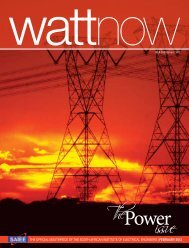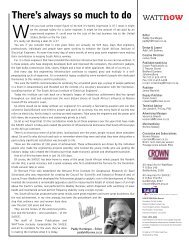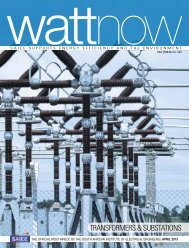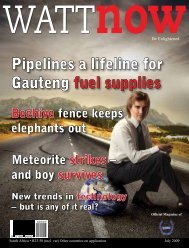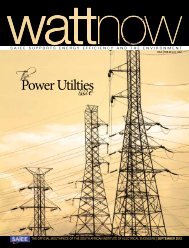download a PDF of the full November 2010 issue - Wattnow
download a PDF of the full November 2010 issue - Wattnow
download a PDF of the full November 2010 issue - Wattnow
Create successful ePaper yourself
Turn your PDF publications into a flip-book with our unique Google optimized e-Paper software.
Hybrids, electric cars tested<br />
The Environmental Protection Agency<br />
in <strong>the</strong> United States estimates that<br />
Nissan’s new Leaf battery-powered vehicle<br />
uses just 2,4 litres <strong>of</strong> petrol per hundred<br />
kilometres and that its range is just 117,5<br />
kilometres, considerably less than Nissan’s<br />
<strong>of</strong>ficial estimate <strong>of</strong> 160 km.<br />
According to Nissan, <strong>the</strong> annual electricity<br />
cost for charging <strong>the</strong> Leaf’s batteries is<br />
just $561. However, <strong>the</strong> company’s director<br />
<strong>of</strong> advanced technology strategy, Mark<br />
Perry, says that <strong>the</strong> driver’s behaviour and<br />
<strong>the</strong> outside ambient temperature both affect<br />
<strong>the</strong> range <strong>of</strong> <strong>the</strong>se vehicles.<br />
The EPA’s estimate <strong>of</strong> 2,74 litres per<br />
100 kilometres is almost half that <strong>of</strong> <strong>the</strong><br />
Toyota Prius with a fuel economy rating <strong>of</strong><br />
4,28 litres per 100 kilometres. The EPA<br />
used 33,7 kilowatt hours as being equivalent<br />
to a gallon <strong>of</strong> petrol and its figures suggest<br />
that <strong>the</strong> Leaf will provide fuel economy<br />
<strong>of</strong> 99 miles per gallon.<br />
Perry says <strong>the</strong> company is happy with<br />
<strong>the</strong> conversion rate applied by <strong>the</strong> EPA. To<br />
calculate <strong>the</strong> annual running costs, a figure<br />
<strong>of</strong> 12 US cents per kilowatt hour was used<br />
but Perry pointed out that <strong>the</strong>se costs vary<br />
considerably from one state to <strong>the</strong> next.<br />
W<br />
Watt Energy<br />
The vehicle will need about seven hours<br />
to charge, using a 240 V socket and consuming<br />
34 kilowatt hours for every 100<br />
miles travelled. It received <strong>the</strong> best scores<br />
among <strong>the</strong> hybrid or electric cars tested for<br />
emissions <strong>of</strong> greenhouse gases or any o<strong>the</strong>r<br />
pollutants.<br />
The EPA tested <strong>the</strong> Toyota Prius and<br />
Chevrolet’s Malibu but has not yet tested<br />
<strong>the</strong> new Chevrolet Volt, a plug-in hybrid<br />
that has a petrol engine that allows <strong>the</strong> car<br />
to be used when <strong>the</strong> battery is flat. The Volt<br />
has a range <strong>of</strong> about 80 kilometres running<br />
on electric power.<br />
Exxaro’s wind power ready by 2012<br />
The first wind power from <strong>the</strong> Brand-se-Baai wind generation<br />
project on South Africa’s west coast will be fed into <strong>the</strong> grid by<br />
<strong>the</strong> middle <strong>of</strong> 2012 claims Chikoma Kazunga, energy growth division<br />
business developer at Exxaro Resources.<br />
The project is currently in a pre-feasibility stage and <strong>the</strong> company<br />
has started its environmental impact assessment. A wind mast that<br />
is 80-metres high has already been erected on site to measure <strong>the</strong><br />
wind resource.<br />
He confirmed that <strong>the</strong> power will be sold to Eskom under <strong>the</strong><br />
renewable energy feed-in tariff scheme. Kazunga says <strong>the</strong> wind farm<br />
is relatively close to Eskom’s grid and Exxaro is currently involved<br />
in discussions with Eskom to establish how much capacity <strong>the</strong> local<br />
sub-station would be able to absorb.<br />
The wind farm has been designed with an initial 50 MW capacity<br />
but this might be boosted to 100 MW depending on <strong>the</strong> results <strong>of</strong><br />
<strong>the</strong> feasibility study.<br />
Brand-se-Baai is located in <strong>the</strong> Western Cape close to Exxaro’s<br />
Namakwa Sands operation. Kazunga says <strong>the</strong> company is also<br />
investigating co-generation opportunities arising from gases that are<br />
generated at <strong>the</strong> Namakwa Sands facility.<br />
He says that <strong>the</strong> initial feasibility study <strong>of</strong> using methane gas for<br />
power generation had been done and indications are that about 300<br />
MW <strong>of</strong> power could be forthcoming from this source. The gas at<br />
Namakwa Sands is currently being flared.<br />
According to Exxaro it is also working on a concentrated solar<br />
power project at Lephalale and an option is to use a solar hybrid<br />
technology that allows <strong>the</strong> solar plant to be augmented with gas or<br />
o<strong>the</strong>r fossil fuels to keep <strong>the</strong> power generation capacity stable.<br />
<strong>November</strong> <strong>2010</strong> 43



